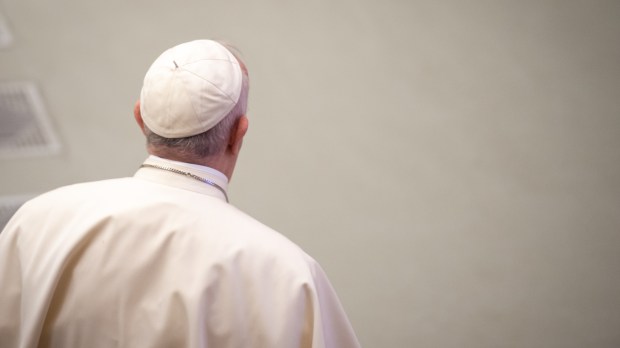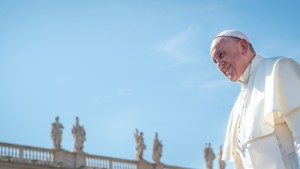After 10 years of pontificate, Pope Francis has already made a number of reforms. But at 86 years of age, the first South American pope in history still is looking to complete a number of strategic projects. We list 10 of them.
1. Synod on Synodality
The Synod on Synodality – which Cardinal Jean-Claude Hollerich, General Relator, prefers to call “Synod on the future of the Church” – is expected to be the seal of a pontificate during which many doors have been opened, but with work still in progress. In Rome, the synodal assemblies of October 2023 and 2024 will be important steps in implementing the Second Vatican Council and developing a more dynamic culture of cooperation between clergy and laity. He may then issue an apostolic exhortation sealing a new way of organizing power in the Church.
2. Reform of the Roman Curia
The concrete implementation of the Apostolic Constitution Praedicate Evangelium on the organization of the Roman Curia will remain a major task for Pope Francis, but also in all likelihood for his successor. The rewriting of the statutes, regulations, and organizational chart of each dicastery could take several more months, if not years, with a new work culture that could cause some tension, especially in terms of fixed-term contracts for new employees. The assumption of responsibility by lay people would be embodied in the first appointment of a woman to head a department. A plausible hypothesis would be the promotion of one of the two undersecretaries, Gabriella Gambino or Linda Ghisoni, as prefect of the Dicastery for Laity, Family and Life. This appointment could possibly take place after the WYD in Lisbon. The current prefect, American Cardinal Kevin Farrell, has already exceeded the theoretical term of his mandate which ended in the fall of 2022.
3. Promised trips
As the 266th pope celebrates his 10th anniversary of pontificate, he already has some 40 trips to his credit, but other plans remain on the table. Two destinations have been confirmed: Hungary, from April 28 to 30, and Portugal, next August for the World Youth Day in Lisbon. The Pontiff has said he will visit Marseille – though not as a state visit to France – in September 2023, on a trip that could also include Mongolia. Several countries are on hold, such as Lebanon, where a trip was planned for June 2022 and then canceled at the last moment, and Southeast Asia (East Timor, Papua New Guinea, and Indonesia), where a trip was planned for September 2020 but canceled due to the pandemic. The Pope also said he was thinking of going to India in 2024 and Turkey in 2025 for the 1,700th anniversary of the first Council of Nicaea. He has also responded positively to invitations from Croatia and Montenegro. In addition, the Bishop of Rome would like to make trips to Ukraine and Russia, as well as to North Korea, but these are difficult to carry out.
4. Crisis with Moscow
Even if it means causing deep annoyance in Ukraine and in some countries directly facing the threat of Moscow, such as Poland, Pope Francis has been keen to maintain open channels of communication with Russia despite the offensive unleashed by Vladimir Putin on his neighbor. Papal diplomacy has maintained contacts with the Russian state, and it will continue this link, however tenuous, as Rome has never taken the initiative to break diplomatic relations with anyone. The other axis of dialogue, perhaps even more complex, is on the level of ecumenical dialogue with the Patriarchate of Moscow. The alignment of Patriarch Kirill with the Kremlin has offended the promoters of this dialogue in the Vatican, but the bridges have not been burned. The Pope’s trip to Hungary, from April 28 to 30, could be an opportunity for discreet contact with Russian Orthodoxy: Metropolitan Hilarion, formerly in charge of external relations for the Moscow Patriarchate, is now posted in this Central European country.
5. German Synodal Way
In his Letter of the Holy Father to the Pilgrim People of God of Germany in 2019, Pope Francis encouraged the process launched by the German episcopate to combat the crisis in the Catholic Church, especially the crisis of abuse. While he has episodically criticized the direction taken by the synodal way, he has never directly commented on the very reformist proposals defended in Germany so as not to interfere, unlike his curial apparatus that has confronted the German bishops on many occasions. With the end of the synodal process on March 11, the pontiff will regain his freedom of action, but no one knows how he will react. Might he put a stop to the various projects that are part of the process? Or will he allow the German bishops freedom of action, at the risk of shocking a significant part of the Catholic world in the rest of the world? Or will he succeed in preventing the German bishops from bringing the most controversial issues to a conclusion? The task looks delicate, all the more so since any intervention on his part could damage the credibility of the Synod on the future of the Church, currently underway.
6. The London building affair
The great financial scandal of the pontificate, the so-called “London building affair,” which began with the acquisition of a property in the British capital by the Secretariat of State in 2014 and continues today in the great trial opened in July 2021 by the Vatican judiciary, is undoubtedly the greatest test faced by the Pontiff in his mission to normalize and rationalize the economy of the Holy See. The scandal has allowed the Pontiff to gradually implement his reform plan, which includes separating the various economic functions and minimizing the financial autonomy of the curial structures, especially that of the Secretariat of State. He also abolished many of the privileges of the “princes of the Church,” even accepting that a cardinal – Angelo Becciu – be sent to civil justice. However, this trial is showing its limits: the lack of means of the Vatican judiciary raises the risk of an unsatisfactory settlement of the trial, whatever the outcome. Concluding this judicial affair would certainly be a thorn in the side of the next pope.
7. The Chinese puzzle
This is one of the most controversial issues of this pontificate. The secret agreement forged in 2018 with the Chinese government over the appointment of bishops is the subject of widespread criticism, both in Rome and within the Chinese Catholic community. For many, the agreement is a betrayal of the Chinese underground Church – Catholics who refuse to obey the “patriotic” Catholic association created by the Communist Party. The Holy See’s gamble on diplomacy under Francis is being sorely tested, and the Vatican itself acknowledges difficulties. Only six bishop appointments have come to fruition since 2018. And differences erupted publicly last November, with the Holy See expressing surprise and consternation for the first time following the installation of a bishop not recognized by Rome. Despite the Pope’s personal desire to keep the channels open, it’s proving difficult for Vatican diplomacy to circumvent the sinicization strategy of Chinese President Xi Jinping and his refusal of foreign interference.
8. Study of female diaconate
Among the open projects is the new study commission on the female diaconate launched on April 8, 2020. Composed of 10 members, including five women, this commission was formed after the failure of a first study group created by the Pontiff in 2016 on the issue, at the request of the International Union of Superiors General (UISG). The result “is not extraordinary,” the Pope commented in 2019, noting that there was no unanimity among the members of the group. According to a source close to the matter, Pope Francis is in possession of the work done by the second commission. It remains to be seen what action he will take and when.
9. Reform of the Diocese of Rome
The day after Benedict XVI’s funeral, on January 6, a new constitution for the Diocese of Rome was released without warning. In it, the Pope profoundly reforms the organization of his diocese to make it more missionary and synodal. The Pope has considerably strengthened his role in the direction of the diocese – previously largely delegated to the Cardinal Vicar of Rome – and is now expected to be involved in the selection of parish priests in the Eternal City. The Pontiff is also establishing two bodies to fight against the abuse of minors and to strengthen financial transparency. For some observers, the Pope intends this constitution to make Rome a model diocese for other bishops. But like his constitution reforming the Curia, this new governance could take time to take hold.
10. Preparing for the Great Jubilee of 2025
In two years, Rome will celebrate a great event orchestrated four times a century: the Jubilee of 2025; Pope Francis has chosen the theme “Pilgrims of Hope.” The Eternal City is expected to see millions of Catholics from around the world flock to St. Peter’s Basilica through the Holy Door for an extraordinary indulgence – that is, remission of the penalties for their sins. Preparations for this special year have already begun, coordinated by the Dicastery for Evangelization. This would be the second jubilee of Francis’ pontificate, following the Year of Mercy in 2016, which was extended to all dioceses around the world.


